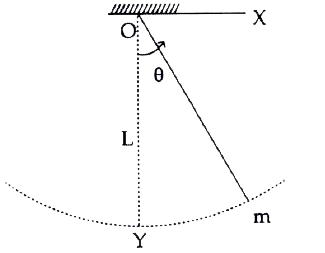A rigid body of mass m is suspended from point O using an inextensible string of length L when it is displaced through an angle θ , what is the change in the potential energy of the mass ?
(Refer adjacent figure.)

mgL(1−cosθ)
mgL(cosθ−1)
mgLcosθ
mgL(1−sinθ)
The correct Answer is:C
A rigid body of mass m is suspended from point O using an inextensible string of length L, when it is displaced through an angle Q. This situation can be described through the following figurer

So, the P.E. of the pendulum at angle θ
= mgh
=mg(L−Lcosθ)
So the change in PE=mgL−mgl(1−cosθ)
=mgLcosθ
Similar Questions
A particle of mass m is suspended from a fixed point O by a string length l.At t=0, it is displaced from its equilibrium position and released.If T is the tension in the string with time t, then the correct graph is
View SolutionA bob of mass 1 kg is suspended from an inextensible string of length 1 m. When the string makes an angle 60∘ with vertical, speed of the bob is 4 m/s
Net acceleration of the bob at this instant is
View Solution
Knowledge Check
A stick of mass m and length l is pivoted at one end and is displaced through an angle θ. The increase in potential energy is
 Amg(l)2(1−cosθ)Bmg(l)2(1+cosθ)Cmg(l)2(1−sinθ)Dmg(l)2(1+sinθ)
Amg(l)2(1−cosθ)Bmg(l)2(1+cosθ)Cmg(l)2(1−sinθ)Dmg(l)2(1+sinθ)A body of mass m is suspended from a massless spring of natural length l. It stretches the spring through a vertical distance y. The potential energy of the stretched spring is
Amg(l+y)B12mg(l+y)C12mgyDMgyA simple pendulum consists of a ball of mass m suspended from the ceiling using a string of length L. The ball is displaced from its equilibrium position by a small angle θ. What is the magnitude of the restoring force that moves the toward its equilibrium position and produces simple harmonic motion?
AkxBmgCmg(cosθ)Dmg(sinθ)
A body of mass m is suspended from three springs as shown in figure. If mass m is displaced slightly then time period of oscillation is

View SolutionA bob hangs from a rigid support by an inextensible string of length l. If it is displaced through a distance l (from the lowest position) keeping the string straight and then released. The speed of the bob at the lowest position is

View SolutionA particle of mass m is suspended from the ceiling through a string of length L. The particle moves in a horizontal circle of radius r. The speed of the particle is
View SolutionA body of mass 1 kg is suspended from a string 1 m long it is rotated in a vertical circle , what is the tension in the string when it is horizontal and the speed of the body is 2m/s ?
View SolutionA particle of mass m is suspended from a fixed O by a string of length L. At t=0, it is displaced from its equilibrium position and released. The graph which shows the variation of the tension T in the string with time t is :

View Solution
